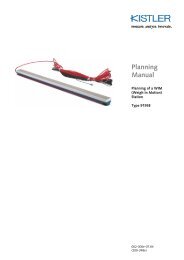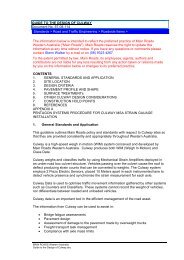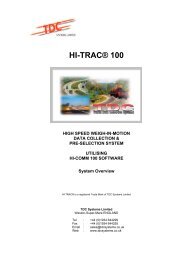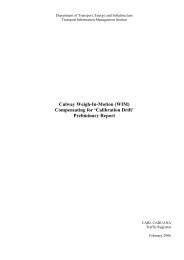AP-G84/04 Best practice in road use data collection, analysis ... - WIM
AP-G84/04 Best practice in road use data collection, analysis ... - WIM
AP-G84/04 Best practice in road use data collection, analysis ... - WIM
Create successful ePaper yourself
Turn your PDF publications into a flip-book with our unique Google optimized e-Paper software.
Accessed by AR - ARRB TRANSPORT RESEARCH on <strong>04</strong> Feb 2005<br />
Aust<strong>road</strong>s 20<strong>04</strong><br />
— 52 —<br />
<strong>Best</strong> Practices <strong>in</strong> Road Use Data Collection, Analysis and Report<strong>in</strong>g<br />
The issue of utilis<strong>in</strong>g <strong>WIM</strong> equipment as part of a traffic count<strong>in</strong>g program is also discussed <strong>in</strong><br />
some detail. As long as all lanes of traffic are monitored at a <strong>WIM</strong> site, the traffic count <strong>data</strong> (and<br />
<strong>WIM</strong> <strong>data</strong>) should add extra value to a count<strong>in</strong>g program. The related issue of correlat<strong>in</strong>g classified<br />
count <strong>data</strong> with vehicle mass <strong>data</strong> is more complex and there is not much <strong>in</strong>formation published on<br />
this topic. In <strong>practice</strong>, if the ratio of loaded and unloaded vehicles at a count<strong>in</strong>g station is consistent<br />
with a nearby <strong>WIM</strong> site, then an accurate estimate of pavement load<strong>in</strong>g can be determ<strong>in</strong>ed.<br />
Road <strong>use</strong> <strong>data</strong> can come from many sources meet<strong>in</strong>g a variety of needs. This leads to the issues<br />
of <strong>data</strong> <strong>in</strong>tegration and accessibility. Many stakeholders are consequently <strong>in</strong>volved. This report<br />
provides a stakeholder consultation model from Ma<strong>in</strong> Roads WA. These issues are rather <strong>in</strong>volved,<br />
and RAs at present have quite varied policies on <strong>data</strong> availability and its pric<strong>in</strong>g. As the trend to<br />
outsource <strong>data</strong> cont<strong>in</strong>ues amongst RAs, third parties may become both supplier and purchaser of<br />
<strong>road</strong> <strong>use</strong> <strong>data</strong>. While these issues were discussed at the October 2003 Workshop and described <strong>in</strong><br />
some detail <strong>in</strong> this report, they will cont<strong>in</strong>ue to confront RAs <strong>in</strong> the future. It is appropriate to<br />
develop, as a future research task, an appropriate policy or bus<strong>in</strong>ess model <strong>in</strong> this area of <strong>data</strong><br />
<strong>in</strong>tegration, accessibility and pric<strong>in</strong>g.<br />
In summary, a list of recommendations is as follows:<br />
1. Vehicle detection - a pair of axle sensors should be considered where possible to give better<br />
accuracy, better dist<strong>in</strong>ction by direction, and the ability to produce classified counts through<br />
axle configurations. If a s<strong>in</strong>gle axle is <strong>use</strong>d, it is a recommended <strong>practice</strong> to correct for traffic<br />
composition and convert axle-pairs <strong>in</strong>to vehicle counts for report<strong>in</strong>g purposes.<br />
2. Vehicle classification - the current Aust<strong>road</strong>s vehicle classification be ma<strong>in</strong>ta<strong>in</strong>ed but allow<strong>in</strong>g<br />
sub-classes as variations of the basic system. It is appropriate to <strong>in</strong>troduce a new notation to<br />
designate different jurisdictional versions, e.g. the Aust<strong>road</strong>s (Vic) for the Victoria version.<br />
3. Error b<strong>in</strong> - an error b<strong>in</strong> (no. 13) be <strong>in</strong>troduced <strong>in</strong>to the Aust<strong>road</strong>s system as good <strong>practice</strong> to<br />
<strong>in</strong>dicate the quality of the classified counts. The number of error counts should be monitored<br />
and, if these rema<strong>in</strong> high relative to the traffic stream, the reasons for these errors should be<br />
identified and the problem rectified. The <strong>in</strong>clusion of error counts <strong>in</strong> b<strong>in</strong> 13 <strong>in</strong> the total counts<br />
requires some judgement. If the number of error counts is high relative to the total counts, it<br />
is necessary to identify the reasons for such a situation before error counts are <strong>in</strong>cluded. If it<br />
is deemed appropriate to distribute b<strong>in</strong> 13 vehicles, the method of distribut<strong>in</strong>g across all b<strong>in</strong>s<br />
from 1 to 12 or only to b<strong>in</strong> 1 can be considered, or both methods are <strong>use</strong>d and guided by<br />
relevant local knowledge.<br />
4. Vehicle classification by length - a variety of threshold values are be<strong>in</strong>g <strong>use</strong>d for vehicle<br />
classification by lengths. It is recommended that RAs come to agreement on a s<strong>in</strong>gle<br />
classification system by lengths. Some empirical work us<strong>in</strong>g a standard loop design would<br />
appear necessary. On reach<strong>in</strong>g agreement, the Aust<strong>road</strong>s system should <strong>in</strong>corporate a<br />
def<strong>in</strong>itive multi-b<strong>in</strong> system by vehicle lengths as a component of the total Aust<strong>road</strong>s<br />
classification system. This harmonisation should facilitate equipment manufactures to design<br />
their equipment for a s<strong>in</strong>gle specification.

















